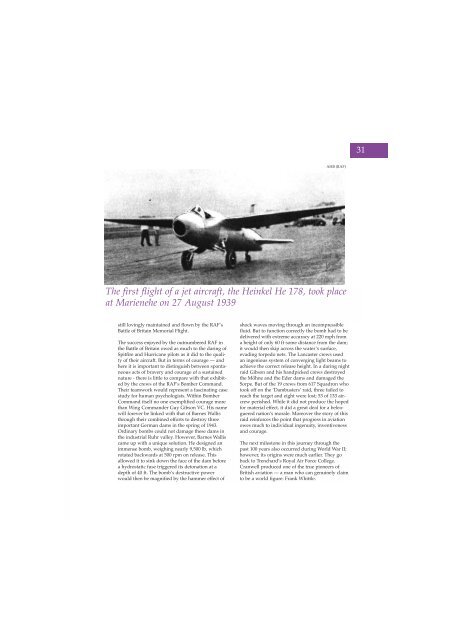Volume 6 No 4 - Royal Air Force Centre for Air Power Studies
Volume 6 No 4 - Royal Air Force Centre for Air Power Studies
Volume 6 No 4 - Royal Air Force Centre for Air Power Studies
Create successful ePaper yourself
Turn your PDF publications into a flip-book with our unique Google optimized e-Paper software.
31<br />
AHB (RAF)<br />
The first flight of a jet aircraft, the Heinkel He 178, took place<br />
at Marienehe on 27 August 1939<br />
still lovingly maintained and flown by the RAF’s<br />
Battle of Britain Memorial Flight.<br />
The success enjoyed by the outnumbered RAF in<br />
the Battle of Britain owed as much to the daring of<br />
Spitfire and Hurricane pilots as it did to the quality<br />
of their aircraft. But in terms of courage — and<br />
here it is important to distinguish between spontaneous<br />
acts of bravery and courage of a sustained<br />
nature - there is little to compare with that exhibited<br />
by the crews of the RAF’s Bomber Command.<br />
Their teamwork would represent a fascinating case<br />
study <strong>for</strong> human psychologists. Within Bomber<br />
Command itself no one exemplified courage more<br />
than Wing Commander Guy Gibson VC. His name<br />
will <strong>for</strong>ever be linked with that of Barnes Wallis<br />
through their combined ef<strong>for</strong>ts to destroy three<br />
important German dams in the spring of 1943.<br />
Ordinary bombs could not damage these dams in<br />
the industrial Ruhr valley. However, Barnes Wallis<br />
came up with a unique solution. He designed an<br />
immense bomb, weighing nearly 9,500 lb, which<br />
rotated backwards at 500 rpm on release. This<br />
allowed it to sink down the face of the dam be<strong>for</strong>e<br />
a hydrostatic fuse triggered its detonation at a<br />
depth of 40 ft. The bomb’s destructive power<br />
would then be magnified by the hammer effect of<br />
shock waves moving through an incompressible<br />
fluid. But to function correctly the bomb had to be<br />
delivered with extreme accuracy at 220 mph from<br />
a height of only 60 ft some distance from the dam;<br />
it would then skip across the water’s surface,<br />
evading torpedo nets. The Lancaster crews used<br />
an ingenious system of converging light beams to<br />
achieve the correct release height. In a daring night<br />
raid Gibson and his handpicked crews destroyed<br />
the Möhne and the Eder dams and damaged the<br />
Sorpe. But of the 19 crews from 617 Squadron who<br />
took off on the ‘Dambusters’ raid, three failed to<br />
reach the target and eight were lost; 53 of 133 aircrew<br />
perished. While it did not produce the hoped<br />
<strong>for</strong> material effect, it did a great deal <strong>for</strong> a beleaguered<br />
nation’s morale. Moreover the story of this<br />
raid rein<strong>for</strong>ces the point that progress in aviation<br />
owes much to individual ingenuity, inventiveness<br />
and courage.<br />
The next milestone in this journey through the<br />
past 100 years also occurred during World War II;<br />
however, its origins were much earlier. They go<br />
back to Trenchard’s <strong>Royal</strong> <strong>Air</strong> <strong>Force</strong> College.<br />
Cranwell produced one of the true pioneers of<br />
British aviation — a man who can genuinely claim<br />
to be a world figure: Frank Whittle.
















